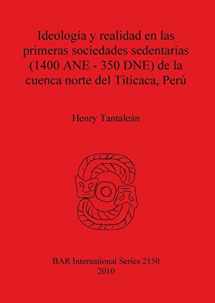
Ideologica y Realidad en las Primeras Sociedades Sedentarias (1400 ANE - 350 DNE) de la Cuenca Norte del Titicaca (BAR International)
ISBN-13:
9781407306919
ISBN-10:
140730691X
Author:
Henry Tantaleán
Publication date:
2010
Publisher:
British Archaeological Reports
Format:
Paperback
448 pages
FREE US shipping
Book details
ISBN-13:
9781407306919
ISBN-10:
140730691X
Author:
Henry Tantaleán
Publication date:
2010
Publisher:
British Archaeological Reports
Format:
Paperback
448 pages
Summary
Ideologica y Realidad en las Primeras Sociedades Sedentarias (1400 ANE - 350 DNE) de la Cuenca Norte del Titicaca (BAR International) (ISBN-13: 9781407306919 and ISBN-10: 140730691X), written by authors
Henry Tantaleán, was published by British Archaeological Reports in 2010.
With an overall rating of 3.9 stars, it's a notable title among other
books. You can easily purchase or rent Ideologica y Realidad en las Primeras Sociedades Sedentarias (1400 ANE - 350 DNE) de la Cuenca Norte del Titicaca (BAR International) (Paperback) from BooksRun,
along with many other new and used
books
and textbooks.
And, if you're looking to sell your copy, our current buyback offer is $0.3.
Description
This study explains the social development of archaeological settlements and artefacts related to the first sedentary societies (1400 BC- AD 350) of the Northern Titicaca Basin, Peru. Such societies passed through a very wide event horizon, but a major influence was the qualitative and quantitative changes in the way these archaeological settlements and objects evolved. This deep change in historical trajectory is related to the existence of a society that produced an unusual complex of buildings and artifacts that are distinguished from others of the Andean area and known under the name of Pukara (400 BC-AD 350). The research is divided into five chapters. Chapter 1 analyzes recent archaeological discourses focused on an objective knowledge of social reality, recognizing the impact of ideologies on the interpretations of archaeologists. Chapter 2 looks at the relationship between dominant ideologies and archaeologies in Peru in the 20th century in Peru. Chapter 3 explores the archaeological discourses on the North Titicaca Basin and it relationship with different ideologies. Chapter 4. Chapter 5 describes the author's programme of archaeological researches into the settlements and artefacts of the first sedentary societies (1400 BC - AD 350) in the area of study (Quilcamayo-Tintiri valley, Puno).


We would LOVE it if you could help us and other readers by reviewing the book
Book review

Congratulations! We have received your book review.
{user}
{createdAt}
by {truncated_author}


